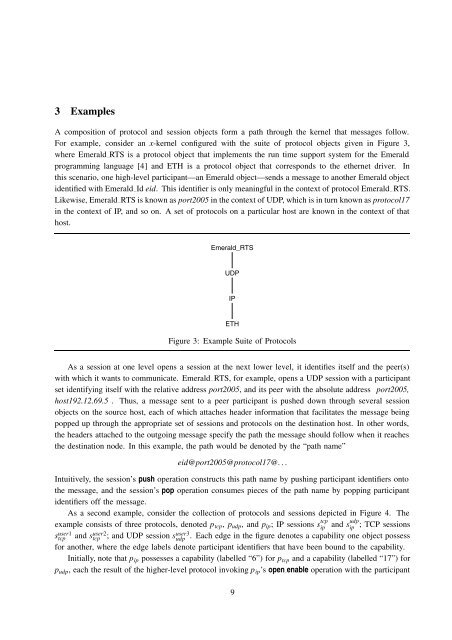The x-Kernel: An architecture for implementing network protocols - IDA
The x-Kernel: An architecture for implementing network protocols - IDA
The x-Kernel: An architecture for implementing network protocols - IDA
Create successful ePaper yourself
Turn your PDF publications into a flip-book with our unique Google optimized e-Paper software.
3 Examples<br />
A composition of protocol and session objects <strong>for</strong>m a path through the kernel that messages follow.<br />
For example, consider an x-kernel configured with the suite of protocol objects given in Figure 3,<br />
where Emerald RTS is a protocol object that implements the run time support system <strong>for</strong> the Emerald<br />
programming language [4] and ETH is a protocol object that corresponds to the ethernet driver. In<br />
this scenario, one high-level participant—an Emerald object—sends a message to another Emerald object<br />
identified with Emerald Id eid. This identifier is only meaningful in the context of protocol Emerald RTS.<br />
Likewise, Emerald RTS is known as port2005 in the context of UDP, which is in turn known as protocol17<br />
in the context of IP, and so on. A set of <strong>protocols</strong> on a particular host are known in the context of that<br />
host.<br />
Emerald_RTS<br />
UDP<br />
IP<br />
ETH<br />
Figure 3: Example Suite of Protocols<br />
As a session at one level opens a session at the next lower level, it identifies itself and the peer(s)<br />
with which it wants to communicate. Emerald RTS, <strong>for</strong> example, opens a UDP session with a participant<br />
set identifying itself with the relative address port2005, and its peer with the absolute address port2005,<br />
host192.12.69.5 . Thus, a message sent to a peer participant is pushed down through several session<br />
objects on the source host, each of which attaches header in<strong>for</strong>mation that facilitates the message being<br />
popped up through the appropriate set of sessions and <strong>protocols</strong> on the destination host. In other words,<br />
the headers attached to the outgoing message specify the path the message should follow when it reaches<br />
the destination node. In this example, the path would be denoted by the “path name”<br />
eid@port2005@protocol17@. . .<br />
Intuitively, the session’s push operation constructs this path name by pushing participant identifiers onto<br />
the message, and the session’s pop operation consumes pieces of the path name by popping participant<br />
identifiers off the message.<br />
As a second example, consider the collection of <strong>protocols</strong> and sessions depicted in Figure 4. <strong>The</strong><br />
example consists of three <strong>protocols</strong>, denoted p tcp , p udp , and p ip ; IP sessions s tcp<br />
ip and s udp<br />
ip ; TCP sessions<br />
s user1 tcp and s user2 tcp ; and UDP session s user3<br />
udp . Each edge in the figure denotes a capability one object possess<br />
<strong>for</strong> another, where the edge labels denote participant identifiers that have been bound to the capability.<br />
Initially, note that p ip possesses a capability (labelled “6”) <strong>for</strong> p tcp and a capability (labelled “17”) <strong>for</strong><br />
p udp , each the result of the higher-level protocol invoking p ip ’s open enable operation with the participant<br />
9

















